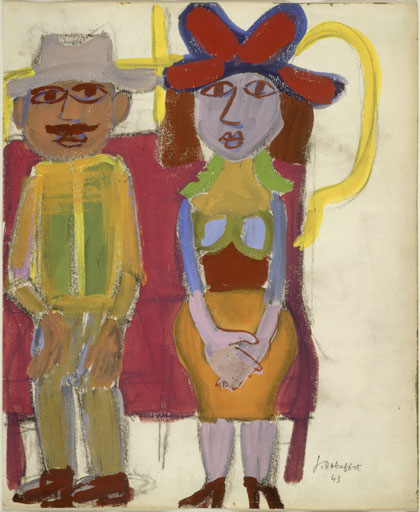Fr : version française / En: english version
mheu, Historical Museum of the Urban Environment
Pair in the series Le Métro
Jean Dubuffet

Date : 1943
Technique : gouache
Size : 86 x 61 cm
Location : MNAM, Centre Pompidou, Paris
Photo credit : ©ADAGP / Collection Centre Pompidou, Dist. RMN / Philippe Migeat
View this work in the Urban transportation exhibition
The work
Far-removed from the bourgeois world of his childhood, the Metro was infinitely fascinating to Dubuffet. It was lively, colorful and full of ordinary people, and he would often wander about in it in raptures. In 1943, he completed a series of twelve gouaches on what was to be a recurrent theme in his work. This series was to inspire the 1949 lithograph illustrations for Jean Paulhan's La métromanie ou les dessous de la capitale (Metromania, or what lies beneath the capital).
The artist
Jean Dubuffet was born in Le Havre in 1901, the son of a prosperous family. His father was a wine merchant. At the age of 17, he set off for Paris to study at Académie Julian, where he met Dufy, Masson, Juan Gris and Fernand Léger, whom he befriended. However, the young Dubuffet had yet to find himself. In 1924, he set off for South America. The following year, he took over his father's business in Le Havre. In 1927, he married and in 1929 he set up shop in Paris as a wine merchant.
Yet painting was in his blood. In 1933, he threw himself back into his art, gradually abandoning the wine business. He divorced, remarried and devoted himself to his art from 1942 onwards, enjoying quick success, with an exhibition at the Galérie Drouin in Paris in 1944, then in New York in 1948. In 1949, Clément Greenberg wrote an article on Dubuffet that brought him great acclaim in the United States, where he also met Pollock and Duchamp. Until his death on May 12, 1985, Dubuffet's fame never faltered: shows included a retrospective at the Musée des Arts Décoratifs in Paris in 1960, at the MOMA in 1962, and at the Guggenheim in 1973.
In 1971, the artist created a Foundation in Paris, which stores all archives and has a collection spanning his entire body of work.